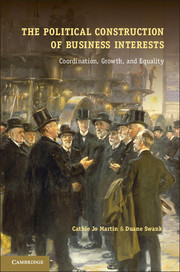Book contents
- Frontmatter
- Contents
- Figures
- Tables
- Acknowledgments
- Introduction
- 1 Collective Political Engagement and the Welfare State
- 2 The Political Origins of Coordinated Capitalism
- 3 Party Conflict and the Origins of Danish Labor Market Coordination
- 4 British Experiments in National Employers’ Organization
- 5 Sectional Parties and Divided Business in the United States
- 6 The Origins of Sector Coordination in Germany
- 7 Twenty-First Century Breakdown? Challenges to Coordination in the Postindustrial Age
- 8 Institutional Sources of Employers’ Preferences for Social Policy
- 9 Employers, Coordination, and Active Labor Market Policy in Postindustrial Denmark
- 10 Employers and Active Labor Market Policy in Postindustrial Britain
- 11 The Failure of Coordination and the Rise of Dualism in Germany
- 12 The Political Foundations of Redistribution and Equality
- Conclusion Social Solidarity after the Crisis of Finance Capitalism
- Bibliography
- Index
5 - Sectional Parties and Divided Business in the United States
Published online by Cambridge University Press: 05 June 2012
- Frontmatter
- Contents
- Figures
- Tables
- Acknowledgments
- Introduction
- 1 Collective Political Engagement and the Welfare State
- 2 The Political Origins of Coordinated Capitalism
- 3 Party Conflict and the Origins of Danish Labor Market Coordination
- 4 British Experiments in National Employers’ Organization
- 5 Sectional Parties and Divided Business in the United States
- 6 The Origins of Sector Coordination in Germany
- 7 Twenty-First Century Breakdown? Challenges to Coordination in the Postindustrial Age
- 8 Institutional Sources of Employers’ Preferences for Social Policy
- 9 Employers, Coordination, and Active Labor Market Policy in Postindustrial Denmark
- 10 Employers and Active Labor Market Policy in Postindustrial Britain
- 11 The Failure of Coordination and the Rise of Dualism in Germany
- 12 The Political Foundations of Redistribution and Equality
- Conclusion Social Solidarity after the Crisis of Finance Capitalism
- Bibliography
- Index
Summary
Introduction
American business organization appears exceptional from a cross-national perspective. Whereas most other advanced nations created a single peak employers’ association to represent business interests, the United States developed two umbrella organizations by 1912 that have competed for power for the past 100 years. The first of these, the National Association of Manufacturers (NAM), initially sought to cooperate with labor and the state, and then led the corporate attack on its former allies. Thus, one wonders why America developed a pattern of fragmentation and redundancy with its multiple umbrella organizations – at a time when other countries were consolidating business representation into unitary organizations – and why NAM switched positions and used coordination to resist rather than to work with the state and labor.
As with Britain, the American experience initially seems easy to explain: A neoliberal, individualistic cultural imperative drove political and economic development. An immense and regionally diverse terrain complicated collective action by employers and a huge domestic market diminished the need for cooperative supports in foreign markets. Weak, craft-based unions did not motivate high levels of business coordination to resist labor, and the absence of an influential guilds tradition worked against the collective production of worker skills. Yet NAM’s puzzling early trajectory does not mesh with the foundation myth of the triumph of American exceptionalism: At its inception, NAM organizers sought to become an encompassing, corporatist peak association to represent all of business and held policy positions (for skills and nonmarket coordination) similar to those of contemporaneous European manufacturers. NAM’s distrust of labor and the state developed only with a sea change, a decade into its organizational life.
- Type
- Chapter
- Information
- The Political Construction of Business InterestsCoordination, Growth, and Equality, pp. 89 - 108Publisher: Cambridge University PressPrint publication year: 2012



